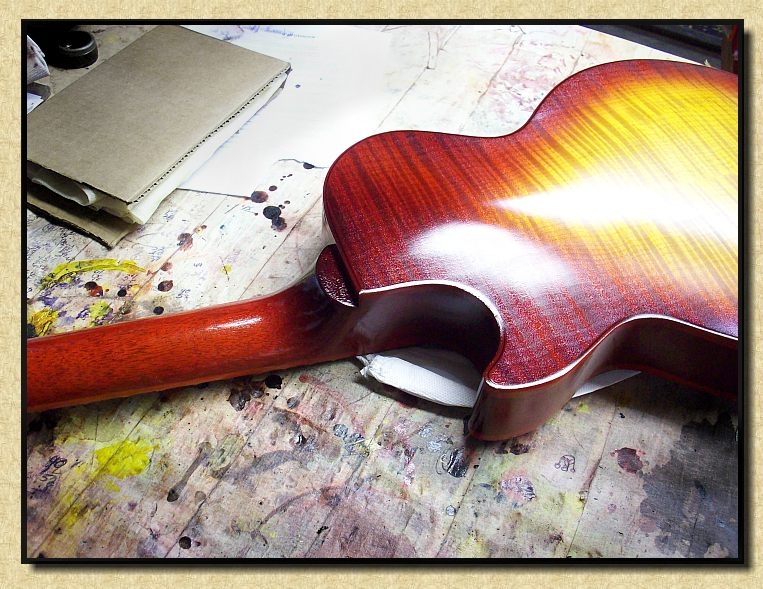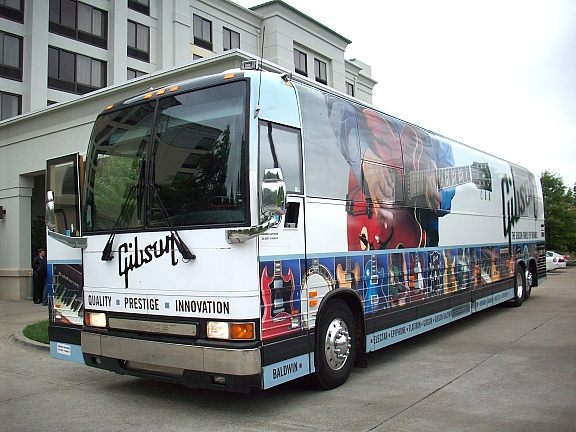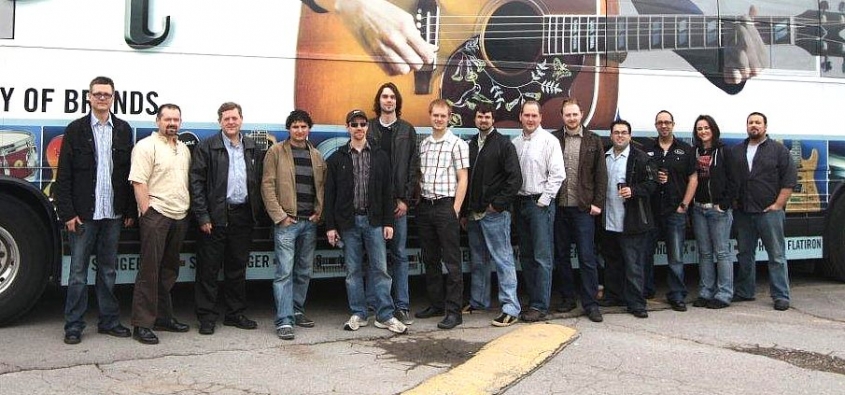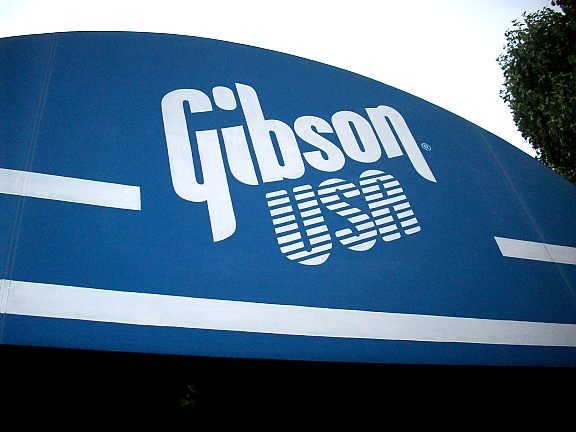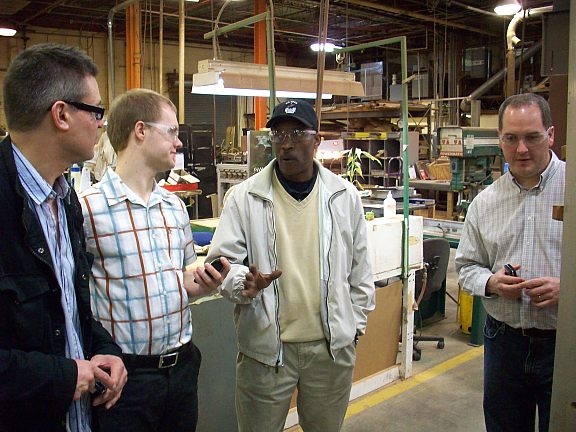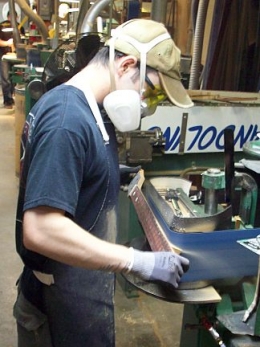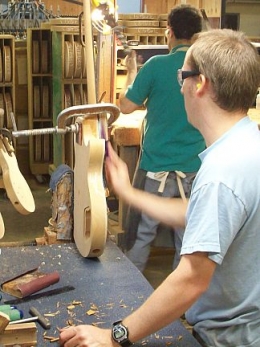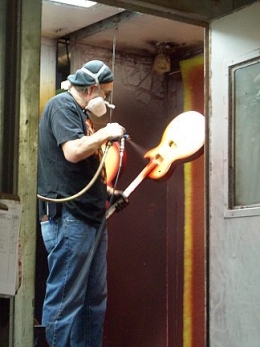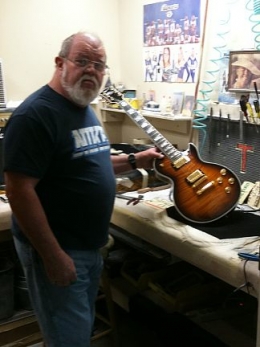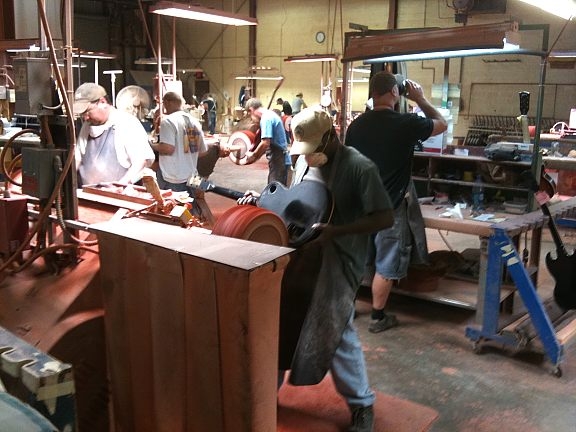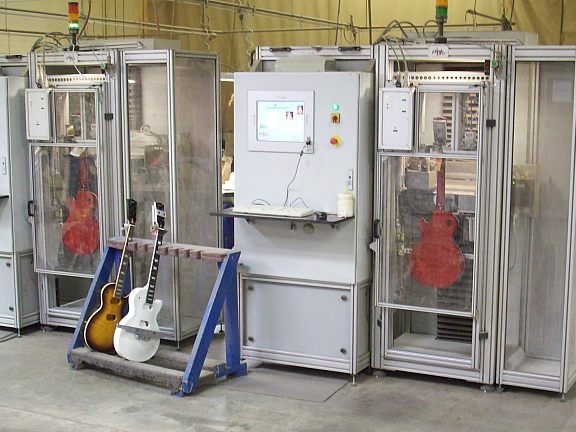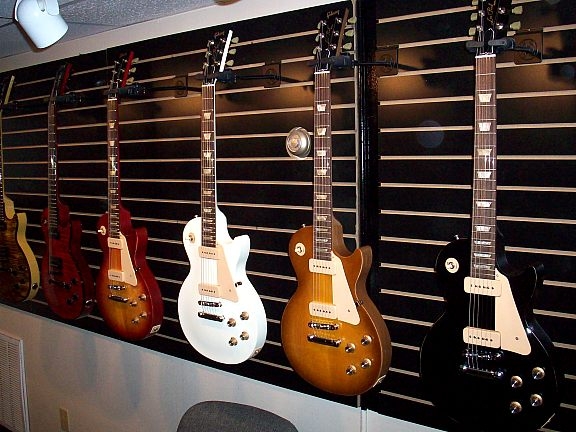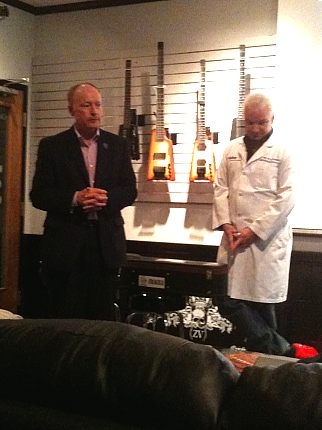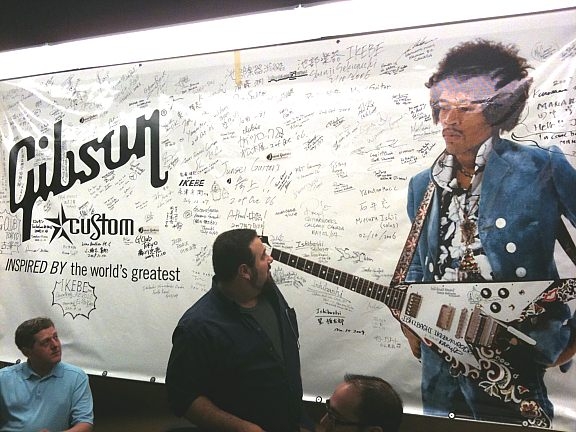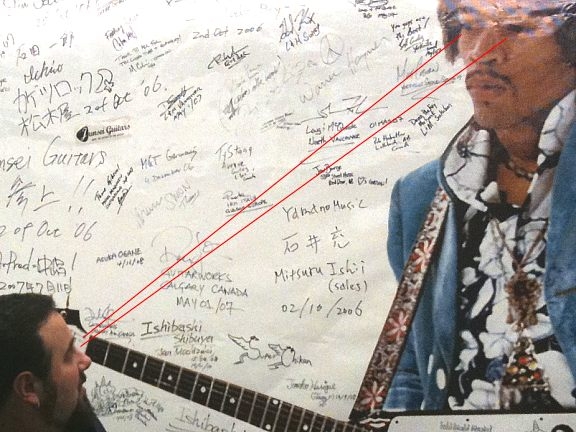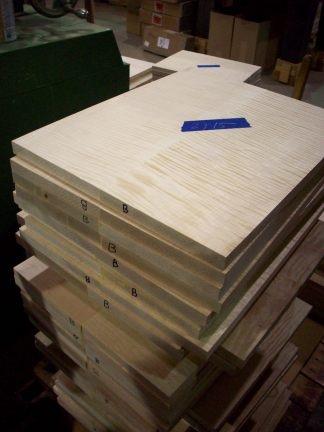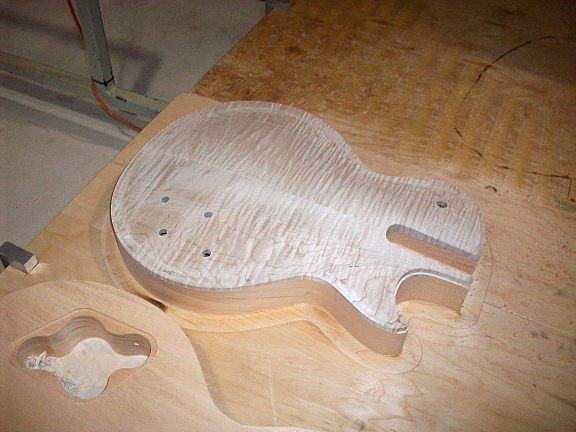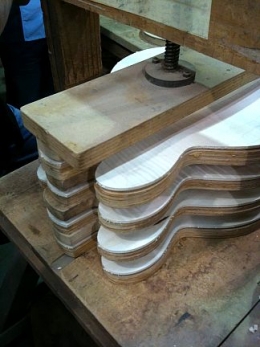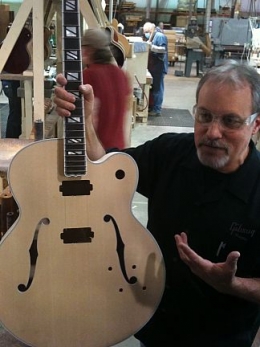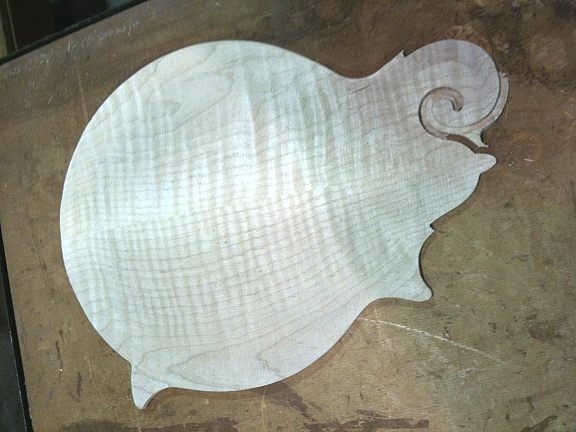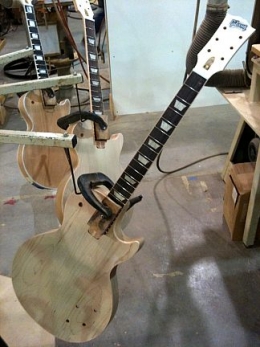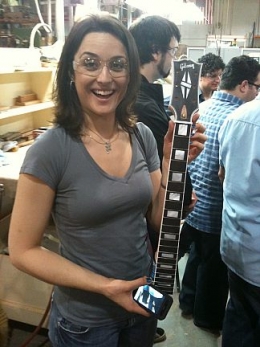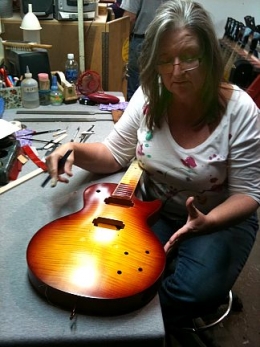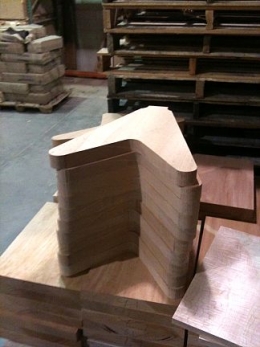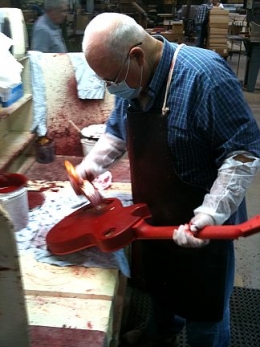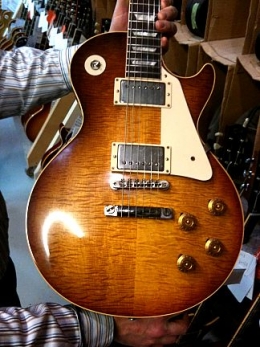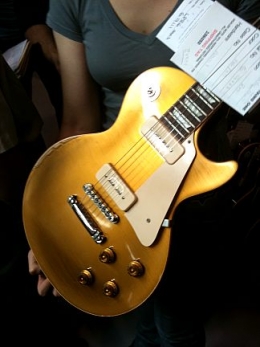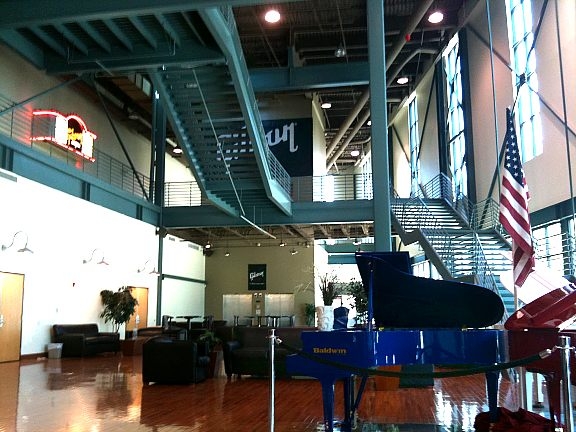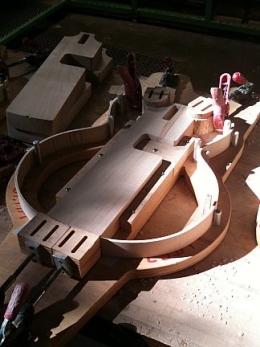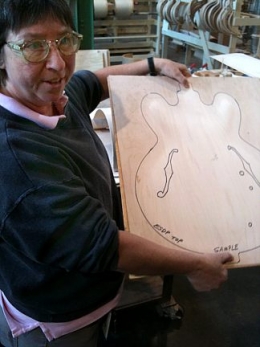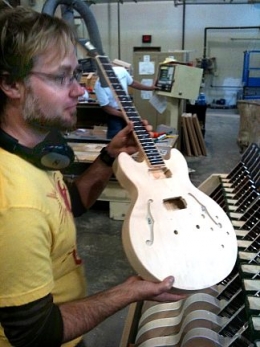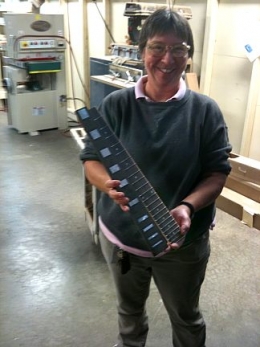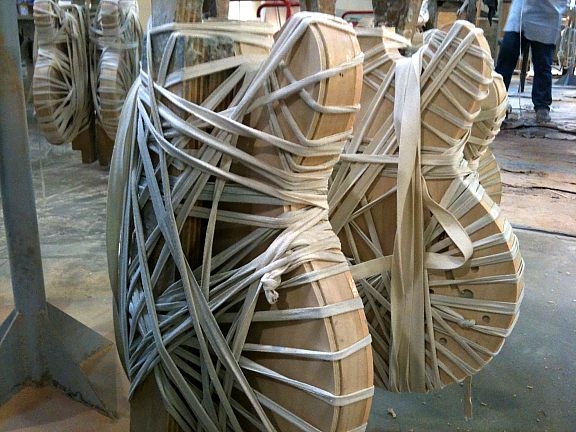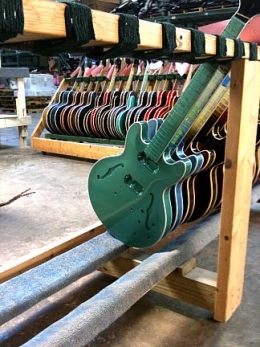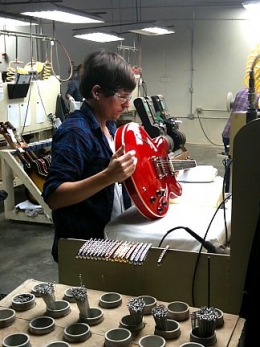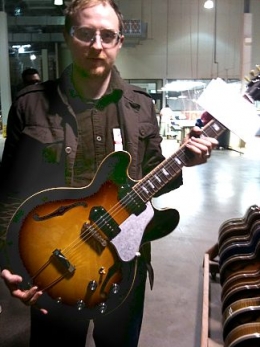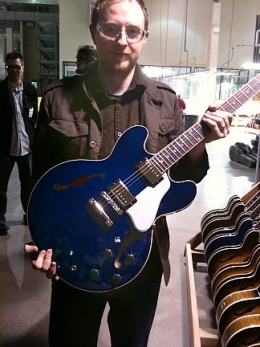On April 25th 2010, I flew to Nashville along with 13 other Canadians to visit Gibson Guitars. Our group was assembled and led by Jeff Cowling and Jeremy Berger of Yorkville Sound; the Canadian distributor for Gibson. Over the next 4 days, our group would visit Gibson USA, Epiphone USA, Gibson Custom in Nashville, and Gibson Custom in Memphis. We were treated to in-depth tours of the guitar building facilities, as well as some hands-on time with new prototypes and upcoming models. We also got to spend some time in two of the most important cities in music history.
Gibson USA
Monday morning is when the real fun began. Our super cool driver Don picked us up in the super cool Gibson Bus. Inside, the bus was outfitted with padded leather seats, full screen TV and stereo system, mini fridge, and about a half dozen guitars and amplifiers plugged in and ready to go. We tried to convince Don to move to Canada and bring the bus with him. I’ll let you all know how that works out. A short drive later, we arrived at the Gibson USA headquarters.
Gibson USA is the main production facility for Gibson guitars. This is the factory that builds the majority of the Gibson product line: Les Paul Studios, Standards, Robots, Traditionals, Supremes, as well as several models of SG, Flying V’s, Explorers, Limited Editions, etc. Over 300 employees build 425 guitars per day in this facility. Our group was split up unto small teams of 4 or 5, then assigned to a Gibson employee who would act as our guide. My group’s guide Carlton has worked at Gibson USA for almost 25 years.
Over the next hour or so, Carlton walked us around the entire factory, stopping at every step in the process to explain what was being done. The first thing that really jumped out at me was just how much of the work on these guitars is done by hand. Once a body shape has been carved by the C&C machine, flesh and blood human beings take over. From pressing inlays, to rolling and setting the necks, binding the bodies, spray finishing, buffing, wiring and installing pickups, final assembly and quality control… every single guitar is held in someone’s hands at every step along the way. The first time Carlton pointed out one of his colleagues scraping finish off the body binding by hand with an exact-o blade, I almost fell over. Despite the high production, there is an incredible amount of old fashioned craftsmanship that goes into every single Gibson guitar.
The one big exception to Gibson’s rule of hand craftsmanship is the Plek machine. Picture a giant brushed chrome refrigerator with plexiglass doors attached to a super-computer, and you’ll have an idea of what it’s like to stand in front of a Plek machine. Better yet, just look at the picture below. Once a guitar is placed inside, the Plek puts tension on the neck equal to the amount of tension created by guitar strings when tuned to pitch. This pulls the neck to the angle it will hold once it has been strung and tuned up. Then a robotic sander glides up and down the fingerboard, sanding and crowning the frets. The Plek also measures and cuts the nut slots to ensure perfect string spacing. This means the frets and nut slots on each guitar are set up as consistently as physically possible. The entire process takes about 20 minutes. Gibson USA has 6 Plek machines running full time. Each machine cost roughly $250,000.
After our tour, we gathered in the meeting room above the factory floor. Our group was met by several people from various departments of Gibson USA, including their Lifestyle department, their woods and materials specialist, as well as the heads of product development and design. We were given a sneak peak of several very exciting new models. I can’t give away much detail yet, but I’ll give you a hint: what’s handmade in the US and will sell for less than $1000? You’ll find out next month! ***Note: The guitars I am reffering to here were in fact the Les Paul Studio 50’s Tribute model, now replaced by the 60’s Tribute model ***
With our time at Gibson USA at an end, we made our way down the road to Epiphone’s office and distribution center. There we were treated to a demonstration by Dr. Will Jones. Along with his impressively entertaining instructional video, Dr. Jones handed out samples of Epiphone’s proprietary hardware used across their product line. It was a pleasant surprise to find such high end components being used on such affordable guitars. We were then given a tour of Epiphone’s distribution center, where every single guitar is unpacked and thoroughly inspected before being repackaged and shipped out to stores across America. In Canada, Yorkville Sound duplicates this process exactly for each Epiphone guitar that comes through their doors.
Nashville Custom Shop
Tuesday morning. With a solid 3 hours of sleep under my belt, I packed my things and checked out of my hotel room in Nashville. We had more yet to do in town, but we would be in Memphis by dinner time. We loaded everything (except for my extra pair of shoes that I left in my room) onto the Gibson Bus and hit the road. Don quickly got us to the Gibson’s Nashville Custom Shop facility. Our host and guide for our time at Nashville Custom would be Thom Fowle. Thom got us settled in a small conference room so we could relax and look at a few display models hanging around the room. Jeremy had a rather strange staring contest with a poster of Jimi Hendrix. Seriously, how could he expect to win that stair down?
Nashville Custom is where Gibson builds all of their historical reissue solid body models (the VOS series, for example), carved arch top guitars, and of course the Les Paul Custom. While every Les Paul built in Gibson USA is chambered for weight relief, the Nashville Custom shop builds exclusively true solid body Les Paul guitars. Although smaller in size than the Gibson USA factory, much of the guitar building process in the Custom shop is fairly similar. There are of course some key design differences in the guitars themselves. Gibson USA places a focus on new and innovative designs, while the Nashville Custom Shop stays truer to history. Thom explained to us the constant struggle he and his facility face to maintain a balance between building guitars that are desirable to players and historically accurate. He picked up a stunning piece of raw flame maple as an example. To paraphrase: “You wouldn’t find many Les Paul guitars built in 1959 with a top that looked this good, but we do it today because it’s what people want”.
As I mentioned earlier, Nashville Custom is also where Gibson produces their solid carved wood Jazz Guitars, such as the L5, Super 400, and CS-336 models. Thom pointed out the original molded presses, some of which are more than 50 years old, still used to build these historic guitars. It was truly amazing to see these guitars being built by hand with the same tools used to create their predecessors. Yet more proof of Gibson’s awareness of their own historical significance, and their commitment to maintain the same standards of quality as time moves on.
One significant difference between Gibson USA and the Nashville Custom Shop slowly dawned on me as our tour continued. I became increasingly aware of a few Gibson employees in particular. More to the point, I realized I was seeing the same individuals at different stations as we moved around the factory. There was absolutely as system of assigned specialization: one team working the buffing wheels, another group rounding necks, etc. But every now and then I would spot a particular builder with the same guitar in his or her hands as they personally performed multiple steps of the building process. I watched one gentleman press an L5 body together, then install the binding himself, then walk across the facility with the guitar in his hands to the wrapping station and wrap the guitar. This is the kind of personal follow through that creates a truly wonderful handmade instrument.
At the end of our tour, Thom led us to the final assembly room where we found rows and rows of finished guitars on stands. Some were spoken for, others were not. Feeling particularly happy about memorizing Grant’s credit card number, I found a couple beautiful pieces for the shop: a VOS Les Paul Special in ebony and a charcoal Les Paul Axis with a stop tail bridge.
Memphis Custom Shop
Our final day of the trip was spent in Gibson’s Memphis Custom Shop facility; a beautiful building right in the middle of downtown. The Memphis Custom Shop has a very impressive public lobby with a full retail store. Greeting us at the front of the building was David Winters. David brought us up through the main offices which overlook the entire factory floor before handing us over to Randi Young for our tour.
Randi was an excellent guide; detailing every step of the process for us. The Memphis Custom Shop builds all of Gibson’s laminate semi hollow bodies, like the ES 335, ES 339, and ES 359. Randi showed us how the laminate boards were traced, pressed into shape, cut and assembled, then bound and wrapped. Just like the Nashville Custom Shop, the factory here in Memphis was using the same presses to form their body shapes that Gibson has used for the past 50 years.
We watched one of the builders carving a neck joint by hand and testing the fit. Similar to Nashville Custom and Gibson USA, the Memphis Custom Shop has recently been outfitted with a Plek machine of their own, allowing the same consistency of fret work and string spacing. Watching the final assembly teams install the pots through the pickup cavity was especially impressive… they made it look easy (trust me, it isn’t). Walking through the racks of finished guitars waiting for final inspection, I spotted a guitar on one particular rack and got very excited. “Is that what I think it is?” I mumbled to Jeremy. “Yes, it is.” He said. “It’s an ES 335 in Pelham Blue”. That’s right, the best looking guitar ever made is on the way!
At the end of our tour, Jeremy and Jeff presented us with a guitar rack covered by a large white bed sheet. Removing the sheet unveiled a row of roughly 15 of the nicest semi hollow bodies I’ve ever seen. Despite the wall of eye candy, 3 guitars jumped out at me instantly. 2 were ES 335s; one in a deep wine red, the other in a dark translucent blue. Both finishes were transparent, revealing incredible figured maple underneath. The 3rd guitar was the ever illusive ES 330L with a vintage sunburst finish. I bought them for the store on the spot.
At the entrance to the Memphis International Airport, we gathered our bags and said goodbye as a group. Thom was still with us, whom we thanked profusely for everything he had done for us over the past 4 days. We said a very heartfelt thanks to Don as well. We then made our way into the airport, and off to our respective homes. There were a few bumps along the way in the form of some canceled flights, but everyone got where they were going eventually. Except for James from Medicine Hat… from what I hear, he’s still at the airport.
Thanks again to everyone from Yorkville and Gibson for this incredible trip. You all put a lot of work into making this happen, and we appreciate it greatly. We’ll have to do it all again next year!
– Nevin Douglas
